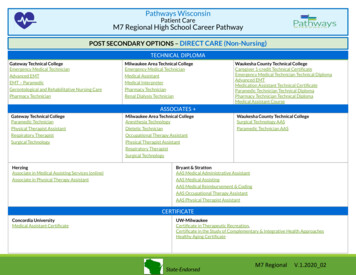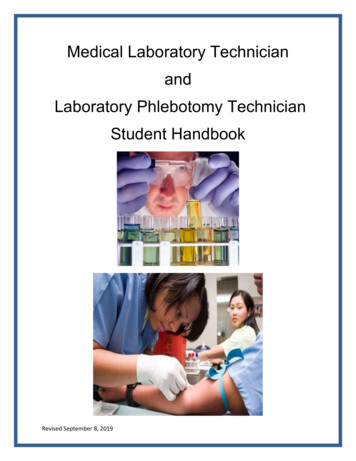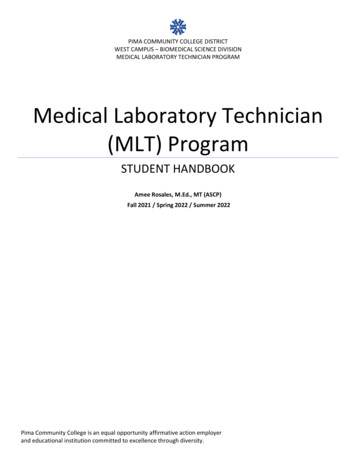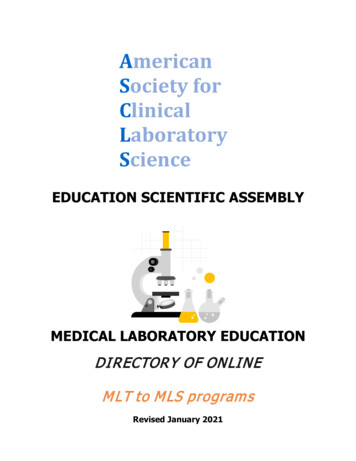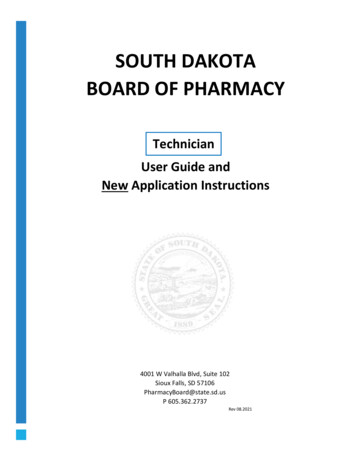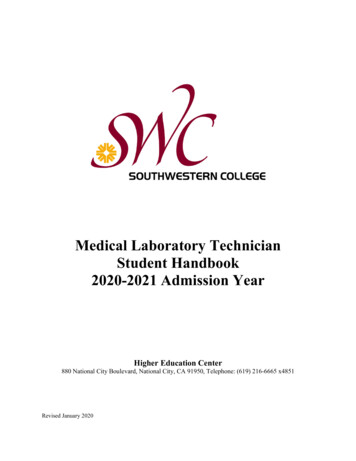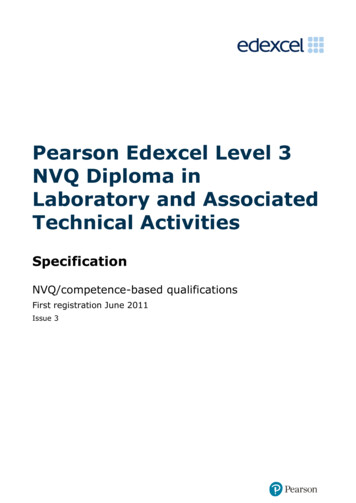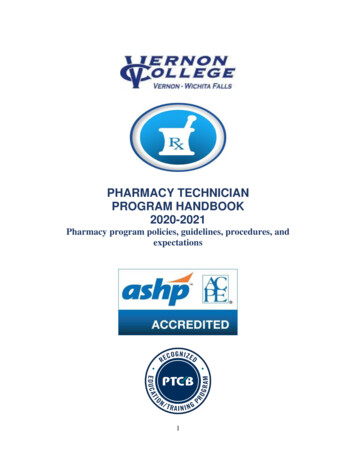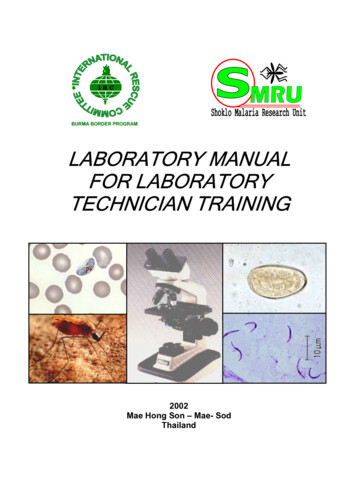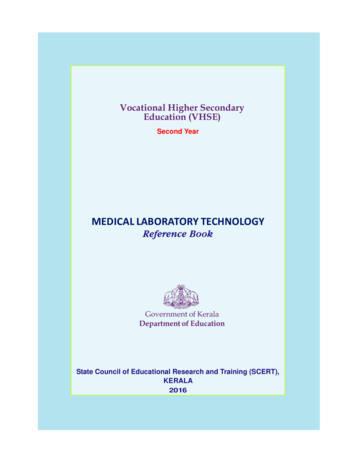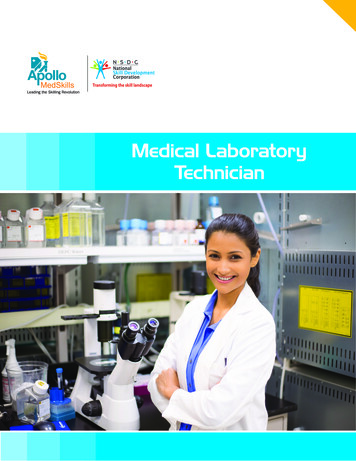
Transcription
Medical LaboratoryTechnician
MEDCAL LORATORY TECHNICIANMEDICAL LABORATORY DULEA BASIC OVERVIEW OF ANATOMY &PHYSIOLOGYCORRECTLY COLLECT, TRANSPORT, RECEIVE,ACCEPT OR REJECT AND STORE BLOODSAMPLESCONDUCT ANALYSIS OF BODY FLUIDS/SAMPLESMAINTAIN, OPERATE AND CLEANLABORATORY EQUIPMENTPROVIDE INFORMATION ABOUT TESTRESULTSPREPARE AND DOCUMENT MEDICAL TESTSAND CLINICAL RESULTSESTABLISH AND MONITOR QUALITYASSURANCE PROGRAMSSUPERVISE AND GUIDE OTHER LABORATORYPERSONNELCONDUCT RESEARCH UNDER GUIDANCEASSIST IN FINE NEEDLE ASPIRATIONCYTOLOGYENSURE AVAILABILITY OF MEDICAL ANDDIAGNOSTIC SUPPLIESACT WITHIN THE LIMITS OF ONE’SCOMPETENCE AND AUTHORITYWORK EFFECTIVELY WITH OTHERSMANAGE WORK TO MEET REQUIREMENTSMAINTAIN A SAFE, HEALTHY, AND SECUREWORKING ENVIRONMENTPRACTICE CODE OF CONDUCT WHILEPERFORMING DUTIESFOLLOW BIOMEDICAL WASTE DISPOSALPROTOCOLSFOLLOW INFECTION CONTROL POLICIES ANDPROCEDURESMONITOR AND ASSURE QUALITYPAGE NO.319273947616675879198104106111113116117122156
Module 1Anatomy and Physiology ofHuman bodyStructure and function of human bodyDifferent parts of body:Composition of Human Body: Material and ChemicalThe human body is the entire structure of a human beingand comprises a head, neck, trunk (which includes the thoraxand abdomen), arms and hands, legs and feet.Material: MuscleEvery part of the body is composed of various types ofcell At maturity, the estimated number of cells in the body isgiven as 37.2 trillion. Fat Bone and teethThe study of the human body involves anatomy andphysiology. Brain and nerves Connective tissueAnatomy is the study of the structure of animals and theirparts. Blood – 7% of body weight. Lymph Contents of digestive tract, including intestinal gas Urine Air in lungs.Physiology focuses on the systems and their organs of thehuman body and their functions.--3 --
Anatomy and Physiology of Human bodyReproductive system: Female reproductive system: The female reproductive system includes the ovaries, fallopian tubes, uterus, vagina, vulva, mammary glands and breasts. These organs are involved in the production andtransportation of gametes and the production ofsex hormones.--15 --The female reproductive system also facilitates thefertilization of ova by sperm and supports the development of offspring during pregnancy and infancy.
CORRECTLY COLLECT, TRANSPORT, RECEIVE,ACCEPT OR REJECT AND STORE BLOODSAMPLESCorrectly collect, transport, receive, accept or reject andstore blood samples Perform procedures to collect blood samples, Study thesamples for their use in the process of transfusionBlood samples are collected for measurement of blood lipidsand glucose. For lipid measurements, serum should be usedin preference to plasma to avoid the diluting effect ofanticoagulants, which results in about 3% difference inconcentrations. Nevertheless, some countries may havespecial reasons to use plasma, e.g. to retain comparabilitywith the earlier surveys. For glucose measurement, plasmais used and glycated hemoglobin measurement requireswhole blood. Blood sample drawing equipment tubes vacutainer holder tourniquet disinfection swabs micropore tape dental rolls adhesive dressing rubber glovespillow or other support separate stoppers for opened vacuum tubes andnon-vacuum tubes needle disposal boxHave a fair knowledge of blood cell biologyPlasma, Red blood cells, White blood cells, PlateletsFor sample drawing the following equipment is neededneedles (preferably vacutainer needles), size 20Gto 22G The main components of blood include:Equipment for sample drawing Module 2--19 --
Module 3OPERATE AND OVERSEE OPERATION OF RADIOLOGIC EQUIPMENTCONDUCT ANALYSIS OF BODY FLUIDS/ SAMPLES C. IndicationsConducting the chemical analysis of body fluids,determine the presence of normal or abnormalcomponents and understand how samples of body fluidsare collected and analysedCSF analysis is performed to diagnose meningitis,intracranial hemorrhage (CVA), leukemias,malignancies, and central nervous system disorders.OVERVIEW OF BODY FLUID ANALYSISD. Specimen CollectionA. In addition to accurate and timely test results, thelaboratory must be prepared to inform the physicianor other medical staff on normal values, reliabilityof test results including medications or othersubstances that could interfere and advise onproper specimen collection.1.Routinely via lumbar puncture under sterileconditions2.Intracranial pressure measured3.Three sterile tubes collectedB. Lab exam of body fluidsa.Tube 1 — Chemistry and serology1.Physical characteristicsb.Tube 2 — Microbiology2.Chemical constituentsc.Tube 3 — Hematology3.Morphologic elements4.Culture for microorganisms5.Ancillary studies4.They should always be considered STAT.E. CSF Physical Characteristics /Appearance, andGross ExaminationCEREBROSPINAL FLUID (CSF)A. Composition and formation1.2.CSF is the third major fluid of the bodya.Adult total volume 140-170 mlb.Neonate total volume 10-60 mlSubarachnoid space - area that lies betweenthe arachnoid membrane and pia mater.Cerebrospinal fluid formed by the choroidplexus cells and ependymal cells occupies thisspace.1.Normally crystal clear and colorless2.Descriptive terms used: clear, hazy, cloudy,turbid, bloody, xanthochromic. These termsshould also be quantitated as slight, moderate,marked, or grossly.3.Other termsA. XanthochromicBlood Brain Barrier - restricts entry ofmacromolecules such as blood cells, largeproteins, lipids. Therefore, the composition ofCSF does not resemble plasma.3.All CSF should be treated with extreme cautionas they can be highly infectious.Absorbed by the arachnoid villusB. Functions1) xanthochromia — term used only for CSF to describea yellowing discoloration of the supernatant BodyFluids MLAB 1211! 52) Causesa) Usually an indication of the presence of oldblood. RBCs have been present in the CSF foran extended period of time, have broken down,released their hemoglobin, and the Hgb hasbeen converted to bilirubin1.To supply nutrients to the nervous tissueb) Elevated serum bilirubin2.To remove metabolic wastes3.Serves as a mechanical barrier to cushion thebrain and spinal cord against traumac) Carotene pigment, merthiolate contaminationand increased proteins--27 --
MAINTAIN, OPERATE AND CLEANLABORATORY EQUIPMENT Performing the standard procedure for cleaning thedifferent parts using appropriate cleaning agents,Performing procedures to keep the unit sterile andfunctional Performance CriteriaIntroductionGood laboratory technique demands clean glassware,because the most carefully executed piece of work may givean erroneous result if dirty glassware is used. In all instances,glassware must be physically clean; it must be chemicallyclean; and in many cases, it must be bacteriologically cleanor sterile. All glassware must be absolutely grease-free. Thesafest criteria of cleanliness is uniform wetting of the surfaceby distilled water. This is especially important in glasswareused for measuring the volume of liquids. Grease and othercontaminating materials will prevent the glass frombecoming uniformly wetted. This in turn will alter the volumeof residue adhering to the walls of the glass container andthus affect the volume of liquid delivered. Furthermore, inpipets and burets, the meniscus will be distorted and thecorrect adjustments cannot be made. The presence of smallamounts of impurities may also alter the meniscus.CleaningWash labware as quickly as possible after use. If a thoroughcleaning is not possible immediately, put glassware to soakin water.If labware is not cleaned immediately, it may becomeimpossible to remove the residue.Most new glassware is slightly alkaline in reaction. Forprecision chemical tests, new glassware should be soakedseveral hours in acid water (a 1% solution of hydrochloricor nitric acid) before washing.Brushes with wooden or plastic handles are recommendedas they will not scratch or abrade the glass surface.Glassware CleanersWhen washing, soap, detergent, or cleaning powder (withor without an abrasive) may be used. Cleaners for glasswareinclude Alconox , Dural ,M&H , Lux , Tide and Fab .The water should be hot. For glassware that is exceptionallydirty, a cleaning powder with a mild abrasive action will givemore satisfactory results. The abrasive should not scratchthe glass. During the washing, all parts of the glasswareshould be thoroughly scrubbed with a brush. This meansthat a full set of brushes must be at hand-brushes to fit largeand small test tubes, burets, funnels, graduates and varioussizes of flasks and bottles. Motor driven revolving brushesModule 4are valuable when a large number of tubes or bottles areprocessed. Do not use cleaning brushes that are so wornthat the spine hits the glass. Serious scratches may result.Scratched glass is more prone to break during experiments.Any mark in the uniform surface of glassware is a potentialbreaking point, especially when the piece is heated. Do notallow acid to come into contact with a piece of glasswarebefore the detergent (or soap) is thoroughly removed. Ifthis happens, a film of grease may be formed.Safe Use of Chromic AcidIf glassware becomes unduly clouded or dirty or containscoagulated organic matter, it must be cleansed with chromicacidcleaning solutionThe dichromate should be handled with extreme care becauseit is a powerful corrosive and carcinogen.When chromic acid solution is used the item may be rinsedwith the cleaning solution or it may be filled and allowed tostand.The length of time it is allowed to stand depends on theamount of contamination on the glassware. Relatively cleanglassware may require only a few minutes of exposure; ifdebris is present, such as blood clots, it may be necessaryto let the glassware stand all night. Due to the intensecorrosive action of the chromic acid solution, it is goodpractice to place the stock bottle, as well as the glasswarebeing treated, in flat glass pans or pans made from lead orcoated with lead, or plastic polymer pans determinedcompatible with the concentration of chromic acid you areusing. Extra care must be taken to be sure chromic acidsolution is disposed of properly.Special types of precipitates may require removal with nitricacid, aqua regia or fuming sulfuric acid. These are verycorrosive substances and should be used only whenrequired.Removing GreaseGrease is best removed by boiling in a weak solution ofsodium carbonate. Acetone or any other fat solvent may beused. Strong alkalis should not be used. Silicone grease ismost easily removed by soaking the stopcock plug or barrelfor 2 hours in warm decahydronaphthalene.Drain and rinse with acetone or use fuming sulfuric acid for30 minutes. Be sure to rinse off all of the cleaning agents.--39 --
PROVIDE INFORMATION ABOUTTEST RESULTS Module 5Providing information to the people, providingappropriate and relevant information about the testshe conducts as and when required. Albumin/globulin ratio BilirubinA comprehensive metabolic panel (CMP) is a blood testthat measures your sugar level, electrolyte and fluid balance,plus kidney and liver function. Our CBC/chemistry profilealso includes a lipid panel and complete blood count (CBC)so you have the opportunity to detect signs of heart disease,anemia, clotting, and immune disorders, as well as metabolicconditions that could threaten your health. Alkaline phosphatase LDH (lactate dehydrogenase) AST (aspartate aminotransferase) ALT (alanine transaminase)Lipid Profile:InstructionsThis test may be done fasting or 2-6 hours after eating. Bothways provide valuable information, though 2-6 hours aftera meal provides a more realistic assessment of the state ofyour blood in everyday life. Stay hydrated and take yourmedications as prescribed.Blood Sugar: Fasting glucoseKidney Function: Total cholesterol Triglycerides HDL cholesterol LDL cholesterol (calc.) VLDL cholesterol (calc.) Total cholesterol/HDL ratio Estimated CHD riskComplete Blood Count: Uric acid Red blood cell count BUN (blood urea nitrogen) Hemoglobin Creatinine Hematocrit BUN/creatinine ratio MCV (mean corpuscular volume) eGFR (estimated glomerular filtration rate) MCH (mean corpuscular hemoglobin) MCHC (meanconcentration) RDW (red blood cell distribution) White blood cell count Differential count Platelet countElectrolytes and Minerals: Sodium Potassium Chloride Calcium Phosphorus IronLiver Function: Total protein Albumin GlobulincorpuscularhemoglobinA comprehensive metabolic panel (CMP) is a blood testthat measures your sugar level, electrolyte and fluid balance,plus kidney and liver function. Our CBC/chemistry profilealso includes a lipid panel and complete blood count (CBC)so you have the opportunity to detect signs of heart disease,anemia, clotting, and immune disorders, as well as metabolicconditions that could threaten your health.--47 --
ESTABLISH AND MONITOR QUALITYASSURANCE PROGRAMSEstablish and monitor quality assurance programsPeriodically monitoring the practices of laboratory,maintaining a comparable quality among competitors ofthe laboratory test resultsThe Good Clinical Laboratory Practices concept possessesa unique quality, as it embraces both the research and theclinical aspects of GLP.Module 7program supports functions in the following areas: Teststandards and controls, reagents, test specimens, review ofquality control data, quality control logs, labeling of qualitycontrol materials and reagents, inventory control, paralleltesting, and water quality testing.Tests controlAppropriately trained and well organized laboratory staffare key to the successful operation of a research facility.Systems are required to drive organizational structure,training and ongoing competency assessment to ensureappropriate accountability and communication during studyconduct.The laboratory must maintain and document acceptancecriteria to test specimens and must follow site-specificinstructions defined in the QC plan to routinely monitoranalytic performance and to identify, document and resolveQC analytical problems. The laboratory must report resultsof specimen testing after ensuring data integrity, quality,and accuracy as described in the QC plan. The latter alsospecifies how the laboratory must proceed when changesof critical analytes occur; how QC logs must documentcontrol results from tested specimens; how all QC materialsand reagents must be prepared, labeled and stored followingthe manufacturer’s specifications; how an inventory controlsystem must be established and followed to maintaincontinuous supply of reagents and materials; how paralleltesting for new lots of reagents must be conducted to bridgewith existing reagents; and how to test water quality toensure that it meets defined tolerance limits as set forth bythe testing requirements.Required Activities and DocumentationReview of Quality Control DataAll personnel must receive direct and detailed training forthe performance of all duties and tasks that they perform.Competency assessments must be conducted and recordedfor all components of the employee’s training and functionalresponsibilities upon completion of initial training. A clinicallaboratory continuing education program that is adequateto meet the needs of all personnel must be documented, andevidence of ongoing adherence by all laboratory personnelmust be readily availableQC must be performed and acceptable results obtained (asdefined in the written QC program) before test results arereported to ensure quality and accuracy of all aspects of thework performed and reported. QC must also be run andreviewed after a change of analytically critical reagents,major preventive maintenance/service, or change of a criticalinstrument component . The laboratory personnel performingthe testing must use the laboratory’s QC program as a guidefor selecting the appropriate corrective action to take forQC data that falls outside of established tolerance limits.Records should include detailed information of actions takenleading to resolution and include staff initials and dates.The laboratory must ensure a corrective action log is presentto facilitate documentation and resolution of QC failures Inthe event the QC data is determined to be unacceptable, thelaboratory must re-evaluate all study-participant test resultssince the last acceptable test run to determine if a significantclinical difference has occurred, in which case, theinstrument QC should be re-established and the affectedtesting repeated .Due to the ambiguity of some parts of the CFR regulations,the GCLP standards are described by merging guidance fromregulatory authorities as well as other organizations andaccrediting bodies, such as the College of AmericanPathologists (CAP), and the International Organization forStandardization. The British Association of ResearchQuality Assurance (BARQA) took a similar approach bycombining Good Clinical Practice (GCP) and GLP in 2003Standards for Organization and PersonnelQuality Control ProgramThe laboratory director or designee should be activelyinvolved in the design, implementation, and oversight of asite-specific, written QC program which defines proceduresfor monitoring analytic performance and consistentidentification, documentation, and resolution of QC issue.This is so as to be able to detect immediate errors as well aschanges that occur over time and hence assure the accuracyand reliability of test results, particularly if the data are usedfor patient management or product advancement decisions.In addition, the laboratory director and/or designee mustdetermine the number and frequency of QC tests, as well asthe appropriate QC materials to use . The quality controlQuality Control LogsQC logs must document control results assayed with eachtest to determine the acceptability of the QC run and to aid--66 --
Module 8SUPERVISE AND GUIDE OTHERLABORATORY PERSONNELSupervise and guide other laboratory PersonnelA medical laboratory is a place where tests are done onclinical specimens and samples in order to get informationabout the health of a patient as pertaining to the diagnosis,treatment, and prevention of disease.Laboratory Services play a critical role in the detection,diagnosis and treatment of disease. Samples are collectedand examination and analysis of body fluids, tissue andcells are carried out. Main services are:To Perform diagnostic testTo Identify organisms, like E-coli bacteriaTo Count and classify blood cells to identify infection ordiseaseTo Operate complex diagnostic equipmentTo Perform immunological tests to check for antibodies The efficient operation of a clinical laboratory andthe effective delivery of medical laboratory servicesto clinicians and their patients require a complexinterdigitating of expertise in medical, scientific andtechnical areas Although the medical, scientific, and technicalexpertise are essential pre-requisites for theprovision of medical laboratory service, success inapplying these techniques to benefit patient careis vitally dependent on:To Type and cross-match blood samples for transfusionsTo Analyze DNAMedical Laboratory Services (Laboratory results) areessential to all aspects of health care and they should be: accurate, reliable, and timely 70% of clinical medicine decision making is predicated upon,or confirmed by medical laboratory test results the management and communication skills oflaboratory directors, supervisors andtechnologists Unnecessary treatmentLaboratory management task is to integrate andcoordinate organizational resources so that qualitylaboratory services can be provided as effectivelyand efficiently as possible Treatment complications Failure to provide the proper treatment Delay in correct diagnosis Additional and unnecessary diagnostic testingIf inaccurate results are provided, the consequences can bevery significant including:Organizational resources include personnel,equipment, money, time and spaceFollowing element should be considered during managementprogram in laboratory:1) Selection and purchasing2) Installation3) Calibration and performance evaluation4) Maintenance5) Troubleshooting--75 --
CONDUCT RESEARCH UNDERGUIDANCEConduct research under guidance Conducting research under the direction and guidanceof Microbiologist or BiochemistThere is no one best way to undertake research, no universalmethod that applies to all scientific investigations. Acceptedpractices for the responsible conduct of research can anddo vary from discipline to discipline and even from laboratoryto laboratory. There are, however, some important sharedvaluesfor the responsible conduct of research that bind allresearchers together, such as so what can we use researchto do in order to gain this new knowledge?Some of the ways it can be used one to:Categorise. This involves forming a typology of objects,events or concepts, i.e. a set of names or ‘boxes’ into whichthese can be sorted. This can be useful in explaining which‘things’ belong together and how.Describe. Descriptive research relies on observation as ameans of collecting data. It attempts to examine situationsin order to establish what is the norm, i.e. what can bepredicted to happen again under the same circumstances.Explain. This is a descriptive type of research specificallydesigned to deal with complex issues. It aims to movebeyond ‘just getting the facts’ in order to make sense of themyriad other elements involved, such as human, political,social, cultural and contextual.Evaluate. This involves making judgements about the qualityof objects or events. Quality can be measured either in anabsolute sense or on a comparative basis. To be useful, themethods of evaluation must be relevant to the context andintentions of the research.Compare. Two or more contrasting cases can be examinedto highlight differences and similarities between them,leading to a better understanding of phenomena.Correlate. The relationships between two phenomena areinvestigated to see whether and how they influence eachother.RESEARCH BASICS 9relationship might be just a loose link at one extreme or adirect link when one phenomenon causes another. Theseare measured as levels of association.Predict. This can sometimes be done in research areas wherecorrelations are already known. Predictions of possibleObstFOLLOW RADIATIONModule 9future behaviour or events are made on the basis that ifthere has been a strong relationship between two or morecharacteristics or events in the past, then these should existin similar circumstances in the future, leading to predictableoutcomes.Control. Once you understand an event or situation, youmay be able to find ways to control it. For this you need toknow what the cause and effect relationships are and thatyou are capable of exerting control over the vital ingredients.All of technology relies on this ability to control.You can combine two or more of these objectives in aresearch project, with sometimes one objective needing tobe successfully achieved before starting the next, for exampleyou usually need to be able to explain how somethinghappens before you can work out how to Control it.RESEARCH DESIGNSThere are numerous types of research design that are Understand the need and importance of research andthe protocols for conducting the sameA protocol or a synopsis of a research project is a documentsubmitted to an authority or an institution for the purposeof1.Ethical clearance2.Formal registration to universities for the award ofa degree or doctorate3.Peer review4.Financial assistance from organizations like ICMR,DST, NACO, DGHS, and MHRDSynopsis is the gist of your planned project submitted forapproval from competent authorities. It gives a panoramicview of your research for quick analysis by the reviewers.Thus, a protocol or a synopsis forms an integral part of aresearch project or a thesis. Many universities have made itmandatory for the postgraduate degree student to preparea thesis as a part of their postgraduate training. A goodknowledge about how a protocol or a synopsis is written isimperative to all people involved in medical research.Literally, protocol (Greek word, protokollon - first page) meansa format procedure for carrying out a scientific research.Synopsis (Greek word, sun - together, opsis - seeing) meansbrief summary of something. Frequently, both the terms areused as synonyms but the term 'synopsis' is used moreoften.--87 --
Module 10ASSIST IN FINE NEEDLEASPIRATION CYTOLOGYASSIST IN FINE NEEDLE ASPIRATION CYTOLOGYDefinition Neck cysts Salivary glands (i.e. parotid gland, submandibulargland) Inside the mouth Any lump that can be feltFine-needle aspiration (FNA) is an invasive procedure usedto analyses lumps or masses. In this procedure, a thin (2325 gauge), hollow needle is inserted into the mass forsampling of cells that, after being stained, will be examinedunder a microscope (biopsy). This technique is called asfine-needle aspiration biopsy (FNAB) or fine-needleaspiration cytology (FNAC)Lumps that are found on imaging tests (such as ultrasound)even if they can't be feltPurpose of FNACPatient preparation FNAC can provide useful information to help todecide on appropriate therapy for condition. It can also be therapeutic for some lesions such ascysts or abscesses, and in many instances willalleviate the need for an open surgical biopsy.Several preparations may be necessary before this procedure.ADVANTAGES OF FNAC No use of aspirin or non-steroidal anti-inflammatorymedications (e.g. ibuprofen, naproxen) for one weekbefore the procedure; No food intake a few hours before the procedure; Routine blood tests (including clotting profile) mustbe completed two weeks before the biopsy;Advantages include: No requirement for anesthesia. Suspension of blood anticoagulant medications; No hospitalization is required. Antibiotic prophylaxis may be instituted. It is easy to perform and is least invasive. It is economical. It has better patient compliance. The results are extremely satisfactory in goodhands. The exact cytological diagnosis is available beforeany definitive surgery is planned.COMMON AREAS FOR ASPIRATIONBefore the procedure is started, vital signs (pulse, bloodpressure, temperature, etc.) may be taken.depending on the nature of the biopsy, an intravenous linemay be placed. Very anxious patients may want to be givensedation through this line. For patients with less anxiety,oral medication (Valium) can be prescribed to be taken beforethe procedure.Evaluating the Patient History of Symptoms:Taking a patient history of symptoms is facilitated withmnemonic "OPQRST":Most fine needle aspirations are done on: Breast thyroid glandlymph nodes in the neck soft tissue swellings any other lump accessible by a needleIndications Onset Who first noticed the condition? What was the patient doing / what was going onwhen the symptoms became apparent (e.g. traumato the area, concurrent infections?) Was the onset sudden, gradual, or appears to bechronic Thyroid Gland Provocation or Palliation Neck lymph nodes Whether any movement, palpation, medications,--91 --
Module 12ACT WITHIN THE LIMITS OF ONE’SCOMPETENCE AND AUTHORITYACT WITHIN THE LIMITS OF ONE’S COMPETENCEANDAUTHORITY Assist patients with prescribed medicationsincluding sublingual nitroglycerine, epinephrineauto injectors, and hand-held aerosol inhalers. Administer oxygen, oral glucose, and activatedcharcoal. Reassure patients and bystanders by working in aconfident, efficient manner and avoid mishandlingpatients and undue haste while workingexpeditiously. Upon arrival at the scene, insure the vehicle isparked in a safe location; perform a size-up todetermine scene safety, mechanism of injury orillness, determine the total number of patients, andrequest additional help if necessary.Where extrication is required, assess the extent ofinjury and give all possible emergency care andprotection to the patient. Use recognized techniquesand equipment to remove patients safely. Radio dispatchers for additional help as necessary.Following extrication, provide additional medicalcare and triage injured victims in accordance withstandard emergency procedures. In the absence of law enforcement, create a safeenvironment for the protection of the injured andthose assisting in the care of patient(s). Determine the nature and extent of illness or injury,take pulses, blood pressure by auscultationpalpation, visually observe changes in skin color,and establish a priority for emergency care. Basedon assessment findings, render emergency care toadults, infants, and children.Comply with regulations on the handling of crimescenes and prehospital death by notifyingappropriate authorities and arrange for protectionof property and evidence. Carry and lift the stretcher, placing it in theambulance and see that the patient and stretcherare secured. Continue care enroute to theappropriate facility. Determine the most appropriate facility for patienttransport unless otherwise directed by medicalcontrol. Report the nature and extent of injuries,the number of patients being transported, and thedestination of patients to ensure prompt medicalcare in accordance with local protocols. Manage medical patients to include assisting inchildbirth, management of respiratory, cardiac,diabetic, allergic, behavioral and environmentalemergencies, and suspected poisonings.Observe and reassess the patient enroute, andadminister care as directed by medical control.Assist with lifting and moving the patient andappropriate equipment from the ambulance into theemergency facility. Search for medical identification emblems, bracelets,or cards that provide emergency care information.Additional care is provided based on assessmentof the patient and obtaining past medicalinformation.Report verbally and in writing, observations andemergency treatment given to the patient, at thescene and in transit, to the receiving staff for recordkeeping and diagnostic purposes. Upon request,provide assistance to the receiving facility staff. After completion o
laboratory must be prepared to inform the physician or other medical staff on normal values, reliability of test results including medications or other substances that could interfere and advise on proper specimen collection. B. Lab exam of body fluids 1. Physical characteristics 2. Chemica
